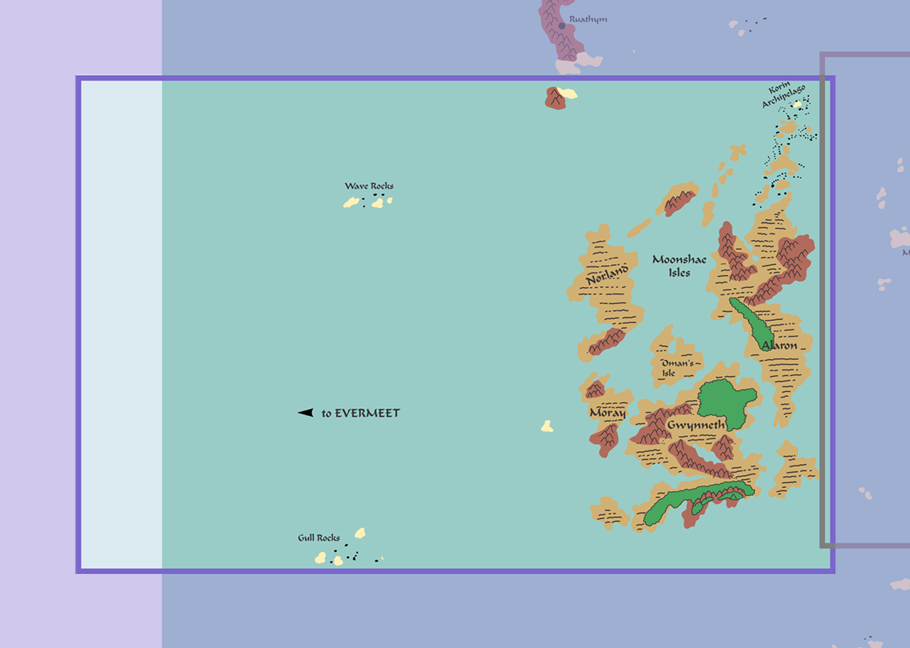Elminster on Moonshae
:strip_icc()/pic518468.jpg) When TSR adopted the Forgotten Reams as it’s new main setting in 1987, the Moonshae Islands became one of the most prominent locales in the setting, absorbing along the way the Korinn Archipeligo, which had been the setting of module N4 (which had not been tied to the Forgotten Realms at the time). The first Forgotten Realms novel was Darkwalker on Moonshae, which was successful and turned into a trilogy, and the second Forgotten Realms setting supplement (FR2) released shortly afterwards was all about the islands.
When TSR adopted the Forgotten Reams as it’s new main setting in 1987, the Moonshae Islands became one of the most prominent locales in the setting, absorbing along the way the Korinn Archipeligo, which had been the setting of module N4 (which had not been tied to the Forgotten Realms at the time). The first Forgotten Realms novel was Darkwalker on Moonshae, which was successful and turned into a trilogy, and the second Forgotten Realms setting supplement (FR2) released shortly afterwards was all about the islands.
Generally speaking, the setting echoes strongly Dark Ages England, with the islands split between the generally Celtic Ffolk, and the obviously Norse Northlanders (I will note that the Ffolk are decidedly Welsh rather than Irish, though the Norse never settled strongly in Wales as they did in Ireland and Germanic-dominated England). A truly interesting wrinkle of the setting was that the Ffolk had a strong druidic tradition worshiping the Earthmother, which was a Gaia-like goddess of the land, rather than the standard Greco-Roman style anthropomorphic deity of D&D mythos.
Sadly, the Goddess was killed off in Darkwell, the third novel of the trilogy (sorry if that’s a spoiler), needlessly reducing the interest of the setting. Since that time, there has been one adventure set there (Halls of the High King), and one further set of novels set there (the Druidhome trilogy), neither of which I am familiar with, and no new supplements focused on the area.
The module itself followed the usual format of the time of a 64-page book printed in the usual Forgotten Realms brown ink with faux-parchment pattern background, with a detached cover. Since there’s no printing on the interior of the cover, and this isn’t an adventure where the cover is separate to act as a DM screen, this is just useless force of habit. There is also a double-sided poster map, with one side depicting the Moonshae islands in the same 30-mile per inch scale as the smaller scale maps of the original boxed set, and is meant continue those maps one panel to the west. Since the isles only take up about half the map at that scale, the reverse is a beautiful map of the Moonshaes at a 20-mile per inch scale. (It should also be noted here that TSR changed color schemes at this point, with much darker colors here and all future FR-series maps than what the boxed set had used).
About half the book is dedicated to an area-by-area description of the islands, broken up by the small kingdoms that exist in the isles. These use the same ‘At a Glance’, ‘Elminster’s Notes’, and ‘Game Information’ format as the original Cyclopedia in the boxed set, but this time Elminster’s notes are the tales of his journey through the islands about a decade previous, and take up the bulk of the section. In fact, the book is dominated by pure fiction, with Elminster’s voluminous tale, and parts of Darkwalker on Moonshae used to introduce all the other sections of the book. This is fairly effective at communicating mood and feel, but is inefficient at getting anything else across, and there there is a dearth of real NPC information, or other detail. In fact, there is but one detail map in the entire volume, a small map of Synnoria, the hidden vale where the Llewyrr (Moonshae’s own offshoot of the elves) live.

Region the FR2 map covers, showing its overlap with the gray box’s detail maps.
That said, the book starts with a decent overview of Moonshae, including availability of races and classes in the region, common conflicts and dangers, a section on trade routes through the area, and what each area produces. There is a section on weather (rainy—almost always), and discussion of the various types of terrain seen in the isles, including random encounter tables for each terrain type (I’m a bit surprised to see Ki-Rin—oriental-style unicorns—showing up in Welsh highlands though). There’s some new magical items at the end of the book, which all make sense for the setting (though the Cauldron of Doom is an obvious, and apropos, shout-out to the Black Cauldron of Chronicles of Prydain fame), and a sparse page of adventure ideas.
Between the fiction and several pages with leftover space, this is the least information-dense setting supplement I can think of. There one real layout disaster, where one section lost some text (it begins in the middle of Elminster’s story after a previous page finished the At a Glance cleanly; there’s some empty room on the previous page that could probably have taken what’s missing), but otherwise no editing problems came to my attention. George Barr does some very nice graphite illustrations for the book, though that too has a problem. A picture of what seems to be Caer Corwell does not follow the description, and is just bad siege engineering to begin with (which is a problem TSR had in general).
In all, the setting is a great idea, the book shows how it is a great idea, but doesn’t do much more than give the barest of starting points for exploring it, though it is good for establishing tone and mood.

Discussion ¬